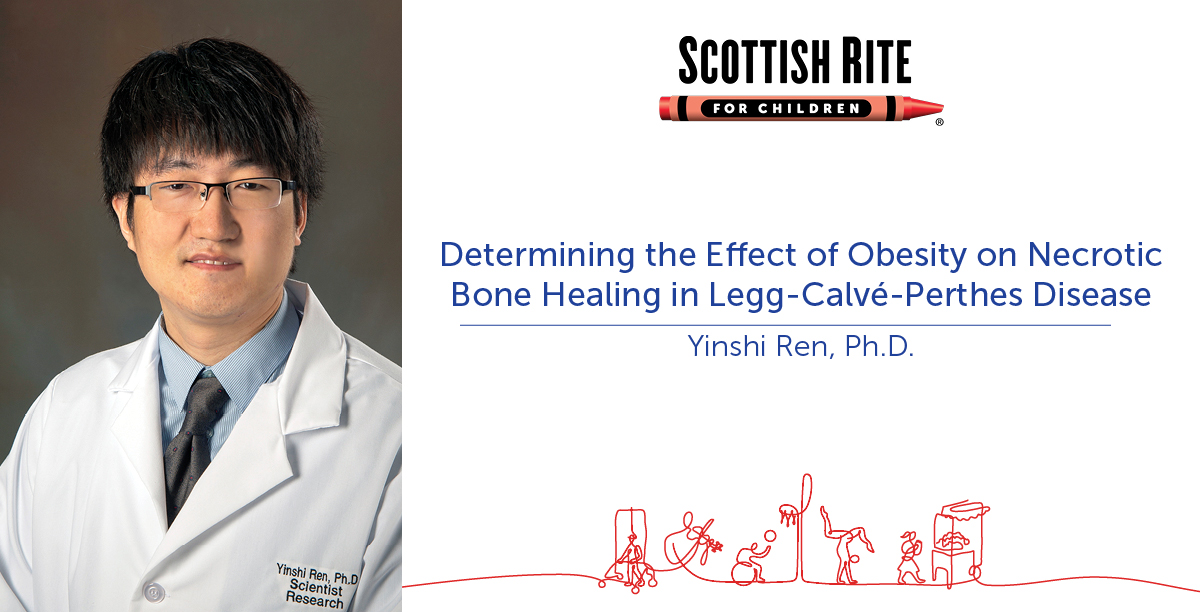
Apr 10, 2020 / Research & Innovation
Staff Scientist Receives Grant to Further Research in Perthes Disease
At Scottish Rite for Children, our team of researchers are dedicated to helping advance treatments – for the common to the most complex of pediatric orthopedic conditions. Doctors and research staff regularly apply for grants throughout the year to help fund their research efforts and projects – especially in areas they are most passionate about.
Staff scientist and assistant professor at UT Southwestern Medical Center Yinshi Ren, Ph.D., recently received a grant from the Pediatric Orthopaedic Society of North America (POSNA) for his work in Perthes disease – a childhood hip disorder that affects the ball portion of the hip joint. Unlike many other orthopedic conditions, the exact cause of Perthes disease is unknown, which is why Ren has put his focus on this topic.
His project, Determining the Effect of Obesity on Necrotic Bone Healing in Legg-Calvé-Perthes Disease, is analyzing the impact obesity may have when healing from Perthes disease. From other research, it is unclear if obesity directly affects the progression of the disease. Through an animal model, Ren will evaluate the following:
“Once the research is completed, it will provide a strong scientific basis on the relationship between obesity and inadequate blood supply to the bone, causing Perthes,” says Ren. “Our team believes that understanding the potential contribution of obesity to osteonecrosis (the death of bone tissue) bone healing, it could help to determine if it is of vital importance in managing the disease conditions and may provide novel strategies for the treatment of Perthes overall.”
Background on Perthes disease and obesity:
1. Pulgaron, E.R. and A.M. Delamater, Obesity and type 2 diabetes in children: epidemiology and treatment. Curr Diab Rep, 2014. 14(8): p. 508.
2. Brady, T.M., Obesity-Related Hypertension in Children. Front Pediatr, 2017. 5: p. 197.
3. Lazar-Antman, M.A. and A.I. Leet, Effects of obesity on pediatric fracture care and management. J Bone Joint Surg Am, 2012. 94(9): p. 855-61.
4. Nafiu, O.O., et al., Childhood body mass index and perioperative complications. Paediatr Anaesth, 2007. 17(5): p. 426-30.
5. Leet, A.I., C.P. Pichard, and M.C. Ain, Surgical treatment of femoral fractures in obese children: does excessive body weight increase the rate of complications? J Bone Joint Surg Am, 2005. 87(12): p. 2609-13.
6. Neal, D.C., et al., Prevalence of Obesity in Patients With Legg-Calve-Perthes Disease. J Am Acad Orthop Surg, 2016. 24(9): p. 660-5.
Staff scientist and assistant professor at UT Southwestern Medical Center Yinshi Ren, Ph.D., recently received a grant from the Pediatric Orthopaedic Society of North America (POSNA) for his work in Perthes disease – a childhood hip disorder that affects the ball portion of the hip joint. Unlike many other orthopedic conditions, the exact cause of Perthes disease is unknown, which is why Ren has put his focus on this topic.
His project, Determining the Effect of Obesity on Necrotic Bone Healing in Legg-Calvé-Perthes Disease, is analyzing the impact obesity may have when healing from Perthes disease. From other research, it is unclear if obesity directly affects the progression of the disease. Through an animal model, Ren will evaluate the following:
- Whether obesity directly affects necrotic bone healing.
- Whether losing weight/reducing calorie intake aids in bone regeneration following ischemic osteonecrosis.
“Once the research is completed, it will provide a strong scientific basis on the relationship between obesity and inadequate blood supply to the bone, causing Perthes,” says Ren. “Our team believes that understanding the potential contribution of obesity to osteonecrosis (the death of bone tissue) bone healing, it could help to determine if it is of vital importance in managing the disease conditions and may provide novel strategies for the treatment of Perthes overall.”
Background on Perthes disease and obesity:
- Childhood obesity has arisen to be a major health concern [1-3].
- Hip joint bears 2 to 2.5 times the weight of patient, thus children with obesity are more vulnerable to joint deformity and collapse. Obese children have also shown to exhibit increased preoperative morbidities and higher complication rates during surgery [4, 5].
- As obesity epidemic continues to increase, children with obesity are put at a higher risk to LCPD and worse outcomes.
- A previous study revealed that obesity is nearly twice as common in children with Perthes disease (32%) compared to the general population (18%), and obese children are often presented at a more advanced stage clinically [6].
- Clinical evidence is still lacking about that if and how childhood obesity directly affects bone healing in Perthes disease.
1. Pulgaron, E.R. and A.M. Delamater, Obesity and type 2 diabetes in children: epidemiology and treatment. Curr Diab Rep, 2014. 14(8): p. 508.
2. Brady, T.M., Obesity-Related Hypertension in Children. Front Pediatr, 2017. 5: p. 197.
3. Lazar-Antman, M.A. and A.I. Leet, Effects of obesity on pediatric fracture care and management. J Bone Joint Surg Am, 2012. 94(9): p. 855-61.
4. Nafiu, O.O., et al., Childhood body mass index and perioperative complications. Paediatr Anaesth, 2007. 17(5): p. 426-30.
5. Leet, A.I., C.P. Pichard, and M.C. Ain, Surgical treatment of femoral fractures in obese children: does excessive body weight increase the rate of complications? J Bone Joint Surg Am, 2005. 87(12): p. 2609-13.
6. Neal, D.C., et al., Prevalence of Obesity in Patients With Legg-Calve-Perthes Disease. J Am Acad Orthop Surg, 2016. 24(9): p. 660-5.



